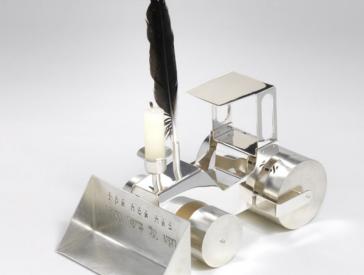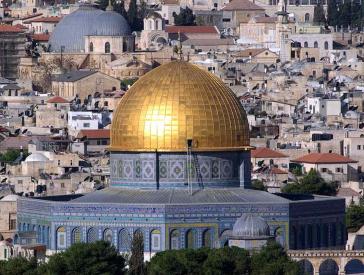“Whatever you want to see – you come to Jerusalem, and you can find it there.”
Comments from Visitors to our Jerusalem Exhibition
I’m standing in the hallway at the end of the exhibition Welcome to Jerusalem, talking to visitors at random if they seem open to a brief conversation about the exhibition.
Was today your first visit to Jerusalem?
Elke (around 50 years old) from Berlin was in Jerusalem in 2000, and some of the things in the exhibition resonated for her. Norbert (69) from Bremen had never been there, but the exhibition made him want to see “this tremendous mish-mash of religions and peoples.”
To Marianna and Marta from Italy, who were just “in the city” for the first time, Jerusalem seemed above all else old, international, and rich in history. Lorenza (54) also from Italy, thought the video installations in the exhibition were particularly interesting because they show modern Jerusalem, which is nonetheless full of tradition. None of the three would wager a real trip to Jerusalem right now because of the political situation.
The Israelis Malka (58) and Shani (27) live near Tel Aviv but are very familiar with Jerusalem. Jonny (27) and Nora (24) even got married there.
Does the exhibition reflect the image of Jerusalem as you know it?
Shani: “Yes, because you can see all kinds of people from Jerusalem in the videos and everything that represents Jerusalem is in the exhibition.”
Jonny: “Yes and no. The way that the exhibition shows all the religions, all the different views and different political classes, all types of people—yes, that’s obviously correct. And it also shows the historical background of Jerusalem. But in the movie about the conflict, I found that it showed the events but it didn’t show what led to these events and why.”
Elke thinks that on the topic of religion, the exhibition is “very balanced on the whole. The exhibition is definitely devoted more to the Jewish tradition, but in every room there is a balance between the religions. And of course, in a Jewish Museum, the focus can lie on Judaism. I find it very fitting though that the others have a voice.”
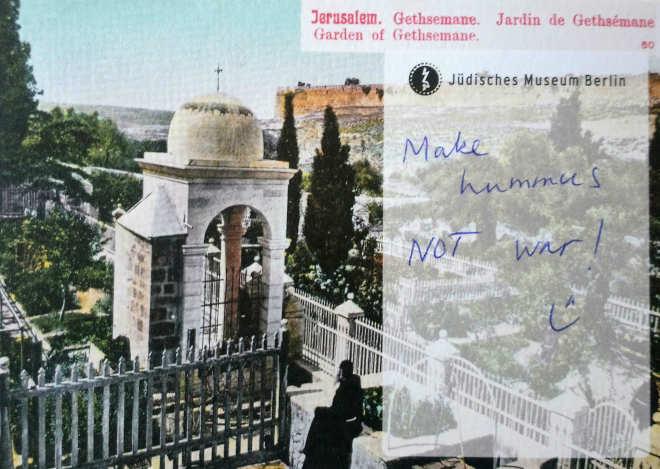 X
X
Visitors can leave a comment, greeting, or anything else that fits on a post card on a wall titled “Next year in Jerusalem” at the end of the exhibition; Jewish Museum Berlin, photo: Mirjam Bitter.
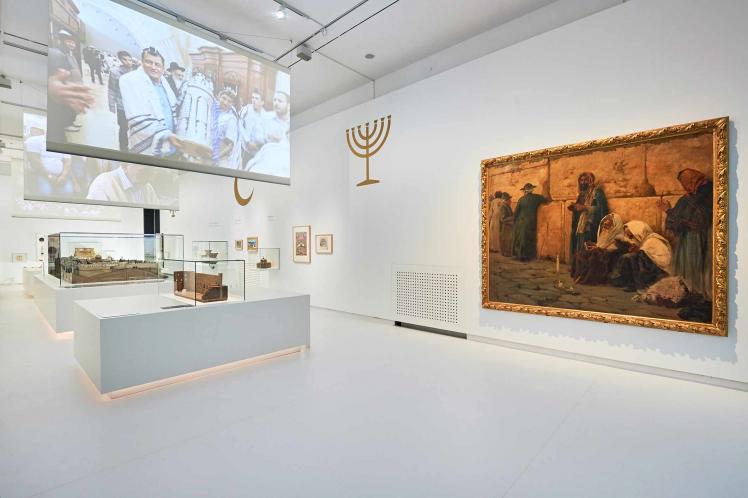
View of the central exhibition room “The Holy City;” Jewish Museum Berlin, photo: Yves Sucksdorff.
What is your connection to Jerusalem?
Since we’ve already presented Israeli voices on this topic here on our website, I mainly approach non-Israelis. The Italians don’t have any personal relationship to Jerusalem.
Elke’s personal connection to Jerusalem has to do with her religion. “I hold a degree as a Christian theologian. I teach at a public school in Berlin. On my visit, I wanted to have a look at cities that have something to do with the Bible, with belief, and, of course, with Judaism. And so there were a few things in the exhibition that were interesting to me, but that I was already familiar with.”
While she finds Jerusalem “extremely interesting in terms of religion,”
she finds “the many conflicts that take place there very depressing.”
Norbert’s connection to Jerusalem is less direct: “I’m an actor. Once I played Shylock. That was a very intensive engagement with Judaism, also in relation to Christianity and the problems of the piece (The Merchant of Venice by William Shakespeare). I notice again and again that it interests me deeply because these religions assert themselves to each other, against each other, and with each other, with their clear visions of how the world is. It’s a very complicated story.”
German history is another point of reference for Norbert (and in that sense he is probably not alone among German exhibition visitors): “Although the Shoa wasn’t directly covered at all in the exhibition, I was constantly thinking of this madness created by the Holocaust; and the aggravation it produced within the Middle East Conflict. It was constantly running through my head that “we” Germans have a huge share of blame for this unresolvable conflict.”
What was your favorite room in the exhibition?
Jonny: “I liked the Christian room. The decorations were very well put-together.”
Me: “The crucifixes?”
Jonny: “Yes.”
Malka: “I think everything was nice.”
Shani: “Yes, because every room you enter tells a different story.”
Malka: “And we know it. We’ve seen it in real life and we can recognize it here.”
Marianna and Marta: “The last one with the post cards. And the Wailing Wall. I knew about it before but in the exhibition it still impressed me.”
Norbert liked the “room with the conflicts”
in particular “because here and there it’s named very clearly what is part of the problem.”
What was your perception of the room about the Middle East Conflict?
Norbert interpreted the room “like in Lessing’s ‘Ring Parable’: What do you do when one person claims ‘I’m the one who it belongs to,’ and not, as Lessing says, that all three claimants are correct.” (Gotthold Ephraim Lessing’s play Nathan the Wise contains a story known as “The Ring Parable,” in which a father owns a magical ring that can make its owner pleasing to God. The father promises the ring to all three of his sons, then makes two more counterfeit versions; the sons fight over which ring is real.) “For me this problem was reflected very clearly in the room – what do you do when the same country is promised to two religions or political systems?”
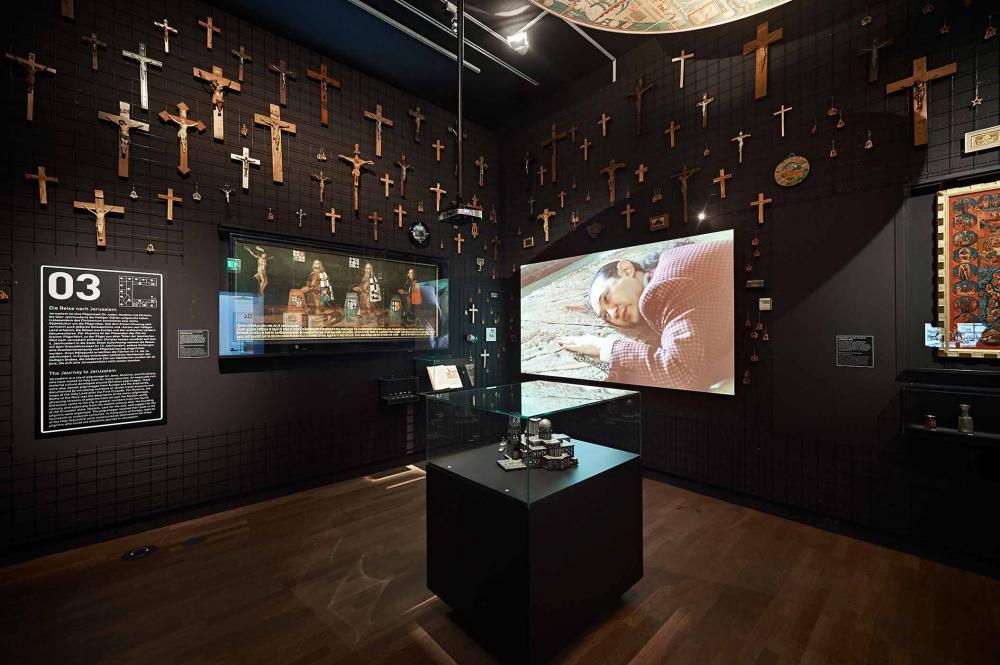 X
X
The exhibition room “Journey to Jerusalem” is dedicated to the pilgrim theme. It is mostly but not exclusively about Christian pilgrimage to Jerusalem; Jewish Museum Berlin, photo: Yves Sucksdorff.
Jonny and Nora criticized the film shown in the Conflict Room:
Jonny: “When it says Israel is going to war, it doesn’t show that every single day Israel has been attacked by its five surrounding enemies. I feel like if outsiders come to watch it, they will be like, ‘Oh the Israelis have a very strong army, they are very aggressive and dominating and are trying to kill off the Palestinians,’ and it’s nothing like that when you actually go to Jerusalem.”
Nora: “The film just portrays all of the violence and none of the good parts: for example that quality of life there is the highest for any Arabs in the Middle East, or that Jews go to the Arab area and buy things from Arabs, and Arabs come to the Jewish area. There is coexistence, you know.”
In contrast, Elke thinks the portrayal of the conflict in the exhibition was more amenable to Israel. In her opinion, the exhibition approved of the establishment of the State of Israel and did not advocate sharing with the Palestinians. “There are moments when the Palestinians speak their part, but fewer. The conflict is represented in a single room, but otherwise it isn’t dealt with much. In the Middle East Conflict, I personally do not stand with Israel, but rather with other groups. The Palestinians lived there first and I think the way the Jews, the Jewish people, behave there is not acceptable with regard to the people that have been there longer. A solution must be urgently found, but I can’t envision it because so much hatred has accumulated on both sides.”
 X
X
It’s clear from the postcards that visitors with very different opinions on the Middle-East Conflict visit the exhibition; Jewish Museum Berlin, photo: Mirjam Bitter.
Lorenza doesn’t advocate so unambiguously for one side. Rather, she deliberates on her limited perspective and her own biases:
“The exhibition did not make me change my opinion, which is against conflicts in general. I don’t really understand what benefits come from building walls or deciding that you can stay and the other person can’t. Even in the case of conflicts from the ancient past. Maybe we can fight about what we think is the right religion by having a discussion and arguing about principles. But the idea of killing someone who does not think like you is so far from the principles of any religion. Maybe my notions are very simplistic, but if you look at the situation, it’s really a pity. I think there are very nice people in Israel and everywhere. But every time I see Palestinians on television who live without water and electricity, I don’t understand why. But more than the Israeli state, I have to complain against the rest of the world, because we also are permitting this state of things. To me it seems that the forces are so unbalanced between the Israelis and the Palestinians that, of course, Israel should try to find a solution. I know, I probably have a limited vision and I have already decided that in some way the Israeli state should try change. In that sense maybe I’m biased in favor of the Palestinians. I know that the Palestinians also did something wrong. They also practice terrorism. They are not ‘the good people.’ But it seems that they are suffering more and that they have less support than Israel.”
After hearing such different opinions about the Conflict Room, I ask Malka and Shani if they don’t have anything to offer on the subject:
 X
X
On this postcard, visitors expressed their wish: “May the wall weaken, creating space for togetherness and peace;”
Jewish Museum Berlin, photo: Mirjam Bitter.
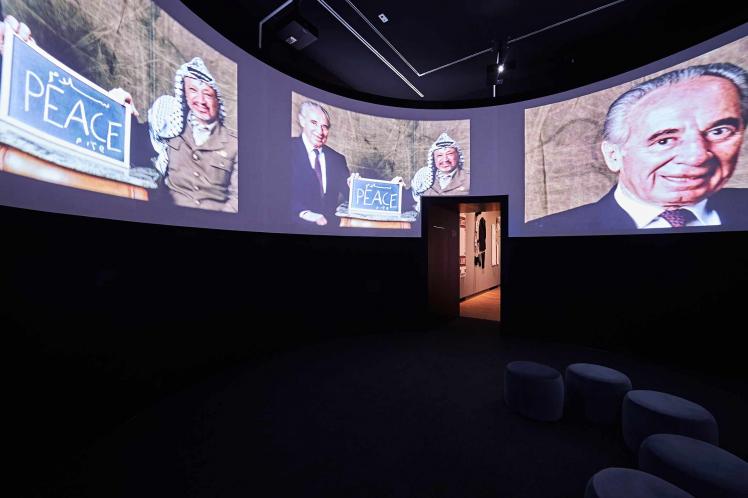
A frame from the film about the conflict from the exhibition; Jewish Museum Berlin, photo: Yves Sucksdorff.
Malka: “Umm…”
Shani: “It’s complicated enough already.”
Malka: “We live in a complicated place with complicated people. And we’re used to it.”
Shani: “It’s very hard to tell everything in one room. You see, it’s not black and white.”
Malka: “It’s impossible to cover it. You have to live it. Every day. Seeing a movie about it…it’s just a movie, not real life.”
Shani: “We need to fight the situation in the media as well. It’s about what the world thinks of us. It’s a very big problem. And this exhibition is good because it also shows the other side. It shows that we also have Muslims and Christians and Jews living together, sometimes on the same street or in the same building. And that’s good. But the world only sees the Palestinians in Gaza.”
Malka: “It’s very hard. And it’s hard for them, too. Not just for the Israelis. Everybody wants peace. We want peace.”
What did I personally learn from these conversations?
I was interested in how visitors perceived the exhibition and the discussion of the Middle East Conflict in it – does the exhibition seem pro-Israel or pro-Palestine, or neutral? I received completely different answers.
Lorenza: “I did not feel that it was for or against something. Honestly. It was more about Israeli history and culture, but I also see the effort not to be too imbalanced. But this is, of course, based upon my previous ideas and knowledge.”
Like Lorenza, I’ve come to the conclusion that people’s perceptions of the exhibition are strongly influenced by our preconceptions and attitudes. And so the opinions I collected and cited here ultimately say more about each visitor than about the exhibition. And what Malka said about the real city may also go for Jerusalem in Berlin:
“I think Jerusalem represents the world. There are many, many people, foods, styles of clothing, and cultures. Whatever you want to see—you come to Jerusalem and you can find it there.”
Florian Schmeling has been to Jerusalem twice, and he knows that he also doesn’t have an “objective” view of the exhibition, and especially not of the conflict – nor does Mirjam Bitter, who arranged the individual interviews for this text.
Citation recommendation:
Florian Schmeling (2018), “Whatever you want to see – you come to Jerusalem, and you can find it there.”. Comments from Visitors to our Jerusalem Exhibition.
URL: www.jmberlin.de/en/node/6441
Behind the Scenes: Entries on the Exhibition “Welcome to Jerusalem” (9)











